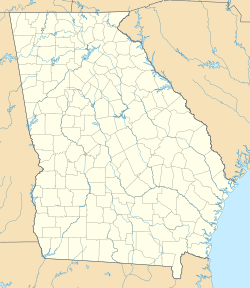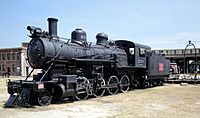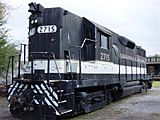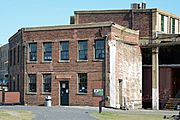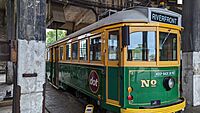Georgia State Railroad Museum facts for kids
|
Central of Georgia Railway: Savannah Shops and Terminal Facilities
|
|
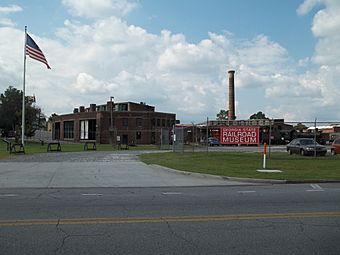
Entrance to the Georgia State Railroad Museum at the former Central of Georgia Railway: Savannah Shops and Terminal Facilities
|
|
| Location | West Broad Street and Railroad Avenue Savannah, Georgia |
|---|---|
| Area | 33.2 acres (13.4 ha) |
| Built | 1853 |
| Architect | Augustus Schwaab; Et al. |
| Architectural style | Late 19th and 20th Century Revivals, Late Victorian |
| NRHP reference No. | 78000970 |
Quick facts for kids Significant dates |
|
| Added to NRHP | June 2, 1978 |
| Designated NHLD | June 2, 1978 |
The Georgia State Railroad Museum is a cool place to visit in Savannah, Georgia. It used to be called the Roundhouse Railroad Museum. This museum is built on a very old and important site. It was once part of the Central of Georgia Railway: Savannah Shops and Terminal Facilities. This whole area is a National Historic Landmark District.
What makes this place special? It's known as the most complete railroad complex from before the American Civil War. This means many of its original buildings are still standing. The museum is located at 655 Louisville Road. It's part of a historic area listed on the National Register of Historic Places.
Right across the street is the Central of Georgia Depot and Trainshed. This is also part of the historic district. The Central of Georgia Railway (CofG) built these buildings in 1853. That was before the Civil War even started! The Savannah Shops and terminal buildings were first named a National Historic Landmark in 1976. More buildings were added to this important list in 1978.
At the Georgia State Railroad Museum, you can see many old railroad buildings. These include a part of a Railway roundhouse with a working turntable. There's also a machine shop, a Tender Frame Shop, and a Blacksmith Shop. You can explore the Boiler House, Storehouse & Print Shop, and Lumber and Planing Sheds. There are also Coach and Paint Shops. A part of the Carpentry Shop now holds the Savannah Children's Museum. Many of these buildings are open for you to look inside!
Contents
What You Can See at the Museum
The Historic Railroad Shops complex is a great example of old railroad buildings. They show how things were designed in the Victorian era. It's the most complete railroad repair complex from before the Civil War in the whole country. The National Park Service officially recognized it as a National Historic Landmark.
When you visit, you'll see many interesting things. There are old machines that run with shafts. You can also see real locomotives and railroad cars. There are even model train layouts! A cool feature is the working turntable. This is a giant spinning platform used to turn train engines around. The museum also has the oldest portable steam engine in the United States. This historic site offers a fun learning experience for students. It's also a very popular place for tourists in Savannah.
The Georgia State Railroad Museum is managed by the Coastal Heritage Society. This is a non-profit group that works with the City of Savannah. They help keep the museum and its history alive.
History of the Railroad Site
The Central of Georgia Railroad started a long time ago, in 1833. It was first called the Central Rail Road and Canal Company. Around 1836, they built a passenger station, a freight terminal, and some shops in Savannah. These first buildings are not there anymore.
By the mid-1840s, the railway had grown a lot. It had about 190 miles (306 km) of track. So, the Central of Georgia began building new shops in 1851. The first building finished was the carpenters' shop in 1853. Then came the original Railway roundhouse, machine shop, tender frame shop, and blacksmith shop. Several other buildings were completed in 1855. More buildings were added to the complex all the way up to the 1920s.
A big fire happened in 1923. After that, the roundhouse, turntable, and other structures were rebuilt in the late 1920s. They were also made bigger to fit larger locomotives and rolling stock. Passenger trains used the Central of Georgia Depot until 1971.
In 1989, a movie called "Glory" was being filmed at the site. This movie was about the American Civil War. During this time, people realized how important it was to restore the old railroad complex. Scott Smith, who had helped restore nearby Fort Jackson, began leading the restoration project. He worked with the City of Savannah to bring the site back to life.
Becoming a Museum
The Southern Railway bought the Central of Georgia in 1963. After that, they closed the Savannah shops. The railway then gave the complex to the City of Savannah. The Coastal Heritage Society, a non-profit group, opened the museum on the site in 1989.
Things to Do at the Museum
When you visit the Georgia State Railroad Museum, you can enjoy many attractions:
- A huge roundhouse with a working turntable. This turntable is 85 feet (26 meters) long!
- Many historic railroad buildings to explore.
- Old machines and stationary steam engines.
- Real steam and diesel engines.
- Special office cars and cabooses.
- Daily tours and fun activities. Sometimes, you can even take a short train ride around the site!
- Cool Model railroad displays.
Gallery
More to Explore


